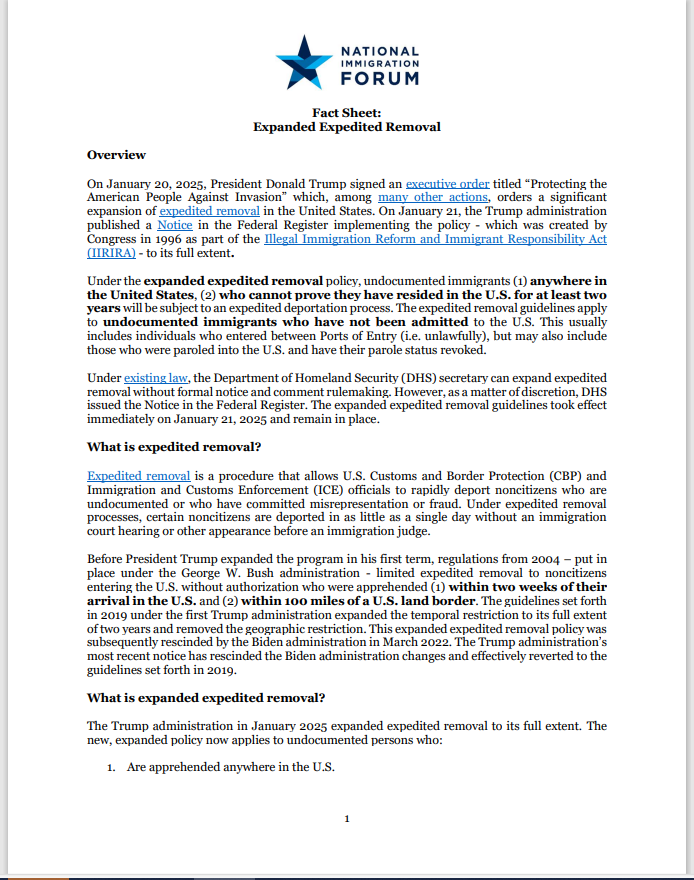
On January 20, 2025, President Donald Trump signed an executive order titled “Protecting the American People Against Invasion” which, among many other actions,orders a significant expansion of expedited removal in the United States. On January 21, the Trump administration published a Notice in the Federal Register implementing the policy – which was created by Congress in 1996 as part of the Illegal Immigration Reform and Immigrant Responsibility Act (IIRIRA) – to its full extent.
Under the expanded expedited removal policy, undocumented immigrants (1) anywhere in the United States, (2) who cannot prove they have resided in the U.S. for at least two years will be subject to an expedited deportation process. The expedited removal guidelines apply to undocumented immigrants who have not been admitted to the U.S. This usually includes individuals who entered between Ports of Entry (i.e. unlawfully), but may also include those who were paroled into the U.S. and have their parole status revoked.
Under existing law, the Department of Homeland Security (DHS) secretary can expand expedited removal without formal notice and comment rulemaking. However, as a matter of discretion, DHS issued the Notice in the Federal Register. The expanded expedited removal guidelines took effect immediately on January 21, 2025 and remain in place.
What is expedited removal?
Expedited removal is a procedure that allows U.S. Customs and Border Protection (CBP) and Immigration and Customs Enforcement (ICE) officials to rapidly deport noncitizens who are undocumented or who have committed misrepresentation or fraud. Under expedited removal processes, certain noncitizens are deported in as little as a single day without an immigration court hearing or other appearance before an immigration judge.
Before President Trump expanded the program in his first term, regulations from 2004 – put in place under the George W. Bush administration – limited expedited removal to noncitizens entering the U.S. without authorization who were apprehended (1) within two weeks of their arrival in the U.S. and (2) within 100 miles of a U.S. land border. The guidelines set forth in 2019 under the first Trump administration expanded the temporal restriction to its full extent of two years and removed the geographic restriction. This expanded expedited removal policy was subsequently rescinded by the Biden administration in March 2022. The Trump administration’s most recent notice has rescinded the Biden administration changes and effectively reverted to the guidelines set forth in 2019.
What is expanded expedited removal?
The Trump administration in January 2025 expanded expedited removal to its full extent. The new, expanded policy now applies to undocumented persons who:
- Are apprehended anywhere in the U.S.
- Cannot prove they have resided in the U.S. for at least two years; and,
- Entered the U.S. between Ports of Entry (POEs) or were paroled into the U.S. and have their parole status revoked.
The expanded expedited removal guidelines do not apply to visa overstayers, though these individuals must be able to show evidence that they were entered the U.S. with a visa. As noted above, people placed in expedited removal may be deported in as little as a single day without an immigration court hearing or other appearance before an immigration judge.
Those who are subject to expedited removal but claim fear of persecution or express an intention to apply for asylum should still receive a credible fear interview before an asylum officer. If they are determined to have a credible fear of persecution, they are removed from the expedited removal process.
The Trump administration’s expanded expedited removal policy has already been subject to litigation. The lawsuit, which was filed in the U.S. District Court in Washington, D.C, argues that expedited removal violates the constitutional right to due process and asks that expedited removal be restricted to the limits instituted by the Biden administration.
Expanded expedited removal & parole
The Biden administration implemented several humanitarian parole programs that admitted close to two million individuals into the U.S. These programs included the use of the CBP One mobile application at the U.S.-Mexico border (936,500 individuals), the Cuba, Haiti, Nicaragua, and Venezuela (CHNV) humanitarian parole program (531,690 individuals), Operation Allies Welcome for Afghan allies following the fall of Kabul in August 2021 (70,000 individuals), and the Uniting for Ukraine (U4U) parole program following the Russian invasion of Ukraine (240,000 individuals). The Trump administration moved to cancel parole statuses for those admitted under CBP One and the CHNV humanitarian parole program. However, those broad cancellations of parole status are facing legal challenges.
DHS published a memo on January 23, 2025 providing guidance on how to use expedited removal for people who were lawfully paroled into the country. The memo directs ICE officers and CBP agents to “[t]ake all steps necessary to review…and consider” whether to place an individual with parole in expedited removal, including using the officer’s “enforcement discretion” to terminate that person’s active parole status. This directive effectively permits immigration officers to individually revoke a person’s parole status and place them in expedited removal – that is, if the person qualifies for expedited removal.
While visa overstayers are not subject to expedited removal, those who enter the U.S. through parole within the last two years may be subject to expedited removal once their parole status ends. This distinction arises because parole is a humanitarian benefit that permits noncitizens to remain in the U.S. if they are applying for admission but do not have a legal basis for that admission. When a parole status ends or is revoked, individuals revert back to their prior immigration status – typically as applicants for admission and, since they are already in the U.S., effectively undocumented immigrants. Because inadmissibility is a prerequisite for receiving humanitarian parole and parolees revert to their prior immigration status upon the termination of their parole status, most former parolees would be considered subject to expedited removal if they have been in the U.S. for less than two years. A few exceptions are possible, including obtaining Temporary Protected Status (TPS) or applying for asylum.
Background
Expedited removal under the first Trump administration
President Trump issued an executive order titled “Border Security and Immigration Enforcement Improvements” upon taking office in January 2017, calling on the DHS Secretary to use their discretion to expand the use of expedited removal to its full extent. On July 23, 2019, DHS issued the notice announcing the expanded expedited removal guidelines.
At the time, DHS claimed that expanding expedited removal “will strengthen national security, diminish the number of illegal entries, and otherwise ensure the prompt removal of aliens apprehended in the United States,” reducing incentives for unlawful entry. DHS further contended that the policy would address “the ongoing crisis at the southern border” and help reduce backlogs in the immigration courts.
Expedited removal under the Biden administration
In March 2022, the Biden administration officially rescinded the first Trump administration’s 2019 notice on expanded expedited removal, returning to the policy that was set before 2019. During most of the Biden administration, expedited removal only applied to those who had entered within the previous 14 days and were encountered within 100 miles of the Canadian or Mexican land borders with the U.S.
The Biden administration pursued expedited removal in other formats. In 2023, the administration authorized the Family Expedited Removal Management (FERM) program, which processed migrant families for removal without detention. The FERM program placed families in a 30-day process, in which families would travel from the U.S.-Mexico border to their destination in the U.S., find an attorney, and prepare for and participate in initial protection screenings. While this program was an alternative to housing families in immigration detention facilities, there were concerns about violations of due process due to the 30-day timeline. Families seeking asylum were put through a speedy adjudication process and then rapidly deported if they failed it.
The Biden administration also utilized expedited removal following the end of Title 42 in May 2023, when the number of people entering expedited removal proceedings increased to more than 20,000 migrants every month.
Impact of expanded expedited removal
More people will face expedited removal
The regulation – combined with the revocation of parole statuses – potentially exposes hundreds of thousands of additional people to expedited removal, limiting their access to immigration hearings and to due process generally. The absence of an immigration court hearing with limited time to obtain counsel prior to deportation is almost certain to lead to people being erroneously deported. This goes counter to our tradition of upholding and protecting due process.
Previously the existence of temporal and geographic restrictions on expedited removal limited the likelihood of improper deportations. Removing these restrictions will inevitably have an adverse impact on those additional people who now could face erroneous removal.
Erroneous deportations will occur
There almost certainly will be instances of people with valid asylum claims or other removal defenses being deported without being able to make their case to an immigration judge. In addition, this dramatic expansion of expedited removal is almost certain to sweep up individuals with legal status, lawful permanent residents (LPRs), and even potentially U.S. citizens who may face accidental deportation with only limited avenues to challenge them.
While people claiming citizenship or another legal status are not subject to expedited removal under the new guidelines, the speed of expedited removal and absence of due process make it more likely that such persons may be erroneously removed. As before, those falsely claiming citizenship are rendered inadmissible and subject to removal.
Civil liberties will be infringed
The Notice purports to place the burden of affirmatively showing that they have been physically present in the U.S. continuously for two years on persons determined to be inadmissible. This raises the possibility that those likely to be questioned by immigration officers – whether citizen or immigrant, documented or undocumented – will be effectively required to carry documentation establishing their citizenship and/or legal presence or demonstrating a two-year period of residency in the United States. The specter of having federal authorities request immigration papers and/or identification to travel in the interior of the United States is a substantial expansion of federal authority and a substantial infringement on civil liberties.
The regime set up by the new expedited removal guideline is likely to sow fear in immigrant communities and to increase instances of racial profiling and discrimination against those groups likely to be asked to show their papers.
Exempted communities
Those who express a fear of return to their home country. If a noncitizen expresses a fear of returning to their home country, they should be referred to an asylum officer for a “credible fear” interview. If the asylum officer determines that the individual has a credible fear of persecution, the noncitizen will be detained and placed in regular removal proceedings, under which they can present their case before an immigration judge.
Visa overstayers are not currently subject to expedited removal. These individuals were legally admitted into the U.S. and entered “with inspection.” This means that they entered through a port of entry (POE) and were admissible at the time of their entrance.
Minors and unaccompanied children are not subject to expedited removal. Unaccompanied children and minors have legal protections which differ from adults in the U.S. immigration system. Due to these protections, unaccompanied children and minors are entitled to go through removal proceedings, where they can present their case before an immigration judge. However, Unaccompanied children (UACs) from contiguous countries (Mexico and Canada) can be immediately returned to their country of origin in lieu of removal proceedings.
.
National Immigration Forum would like to thank Katia Diamond-Sagias, Policy and Advocacy intern, for helping to develop this explainer.


